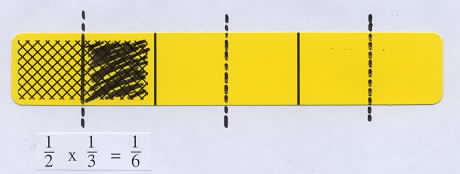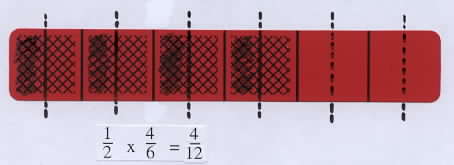
Group Activities:
a. Select an arbitrary bar with one part shased, determine 1/2 of the shaded amount, and write the resulting product. This can be done by drawing on the bars with water-base pens or tracing a bar on paper and dividing the shaded amount into two equal parts. Discuss some of the results.
Then ask students to select any bar with an even number of shaded parts, write its fraction, and determine the fraction for half of this amount. For example, if the bar below for 4/6 is selected, one of the following methods shown might be used: take half of the shaded parts, as shown on the left below; or split one of the shaded part in half to get 1/12 and do this for all four shaded parts, as shown below on the right. Point out that this second method leads directly to the product 1/2 x 4/6 = 4/12, which illustrtes the standard algorithm for multiplying fractions:
-numerator times numerator and denominator times denominator-


Example: If sister has 1/3 of a cake and gives her brother 1/2 of it, how much will he have?
We can help students overcome this belief by connecting multiplication of whole numbers to multiplication of fractions by teaching that the first number in a product tells what to do with the second number. If the first number is a whole number, it can tell us to take the second number zero times, one time, or many times (repeated addition). If the first number is a fraction less than one, then the product will be smaller than the second number because fractions less than one tell us to take part of an amount. In this case multiplication produces a smaller number.